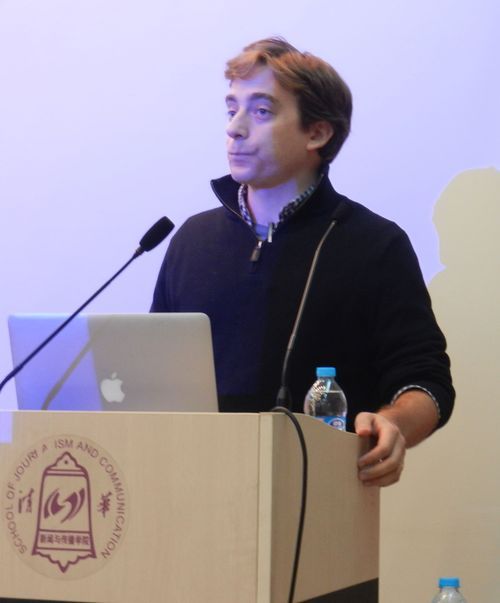
New Yorker writer Evan Osnos is as fine a storyteller in person as he is in print. Tsinghua University journalism students left their texting thumbs idle Oct. 24 as he told how he profiled a former barber named Siu Yun Ping, who won close to $100 million at baccarat in Macau.
Osnos shared some trade secrets about writing for The New Yorker, which is known for its profiles of the famous and obscure.
The best writing starts with deep reporting, he said. It flows from the detail gathered from court documents, news clips, obscure academic dissertations, neglected public archives and reluctant interview subjects. In other words, gather the facts, and you will have the material for colorful writing.
The best writing starts with deep reporting, he said. It flows from the detail gathered from court documents, news clips, obscure academic dissertations, neglected public archives and reluctant interview subjects. In other words, gather the facts, and you will have the material for colorful writing.
He told the students a reporter has to push beyond the point where most give up in order to get a piece published in The New Yorker, where the standard is to make people with no interest in a topic – say, gambling at Macau's casinos – read a profile all the way to the end.
The story about the gambler ("The God of Gamblers," April 9, 2012) began with an editor's query: Are you interested in Macau? As it happened, he was. He had been saving some clippings in a “possibles” file and had done some reading. He was particularly interested in a crime story from 2007 that involved an employee of a casino trying to have a successful gambling figure killed. Osnos thought this could be the center of the piece.
Eventually he organized his research and writing around several elements:
- How Macau has made itself five times bigger than Las Vegas in gambling revenues in a half-dozen years.
- Why Macau exists as an appendage of China and how it fits into the country's history, politics and economy.
- Macau's role as a center of money-laundering for people who want to move money out of China.
- The science of gambling and why Chinese tend to take bigger financial risks than, say, Americans.
- And finally, the narrative itself. Who was this person who won millions by gambling at baccarat and how did he survive mob attempts to have him killed.
One of the challenges in writing the story was finding people to talk about how criminal activity works. “You can't just call up a member of the mafia and get them to talk with you.” However, there were records of testimony by several of the mob figures accused of attempted murder in Siu's case.
Osnos also found a doctoral dissertation that quoted a survey of officials convicted of corruption. In the survey they described how the system worked. It was a spider's web of connections in which everyone got a little piece of the action in exchange for keeping quiet.
And finally, he had to interview Siu, the gambler himself. "For a New Yorker profile, you have to get the guy." You can't write a profile without interviewing the main subject. But no one seemed to know where to find him.
Eventually, a television reporter tipped Osnos to a news story that mentioned Siu was developing some homes in an outlying area of Hong Kong. Siu avoided him, did not want to talk. Finally, Osnos met Siu face to face on the construction site and persuaded him to sit down for an interview.
"You have to push through those doors" when you find yourself blocked from gathering information, Osnos told the students. "You have to be creative and persistent." That is especially true in China, where business people are reluctant to talk with the press.
An Osnos tip: Always be smiling. People will find you less threatening and will be more likely to tell you things than if you come across as a hard-charging reporter. (Thanks to Nicole Sy for this.)
How journalist built his brand from college dorm room
CUNY aims to incubate new media
You create more value with 'community' than 'audience'
Mark Briggs: create labs for journalism innovation
Review: How to Make Money Publishing Community News Online
Great piece, Jim. I'm sharing this with students and colleagues here in Nebraska.
ReplyDelete